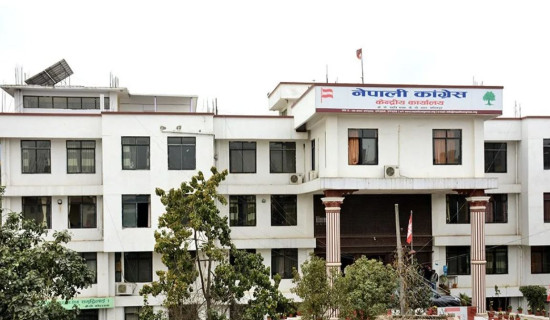- Monday, 20 May 2024
Permaculture: A Triple-Win Solution
In the developing world, smallholder farmers produce the bulk of the food that is consumed. No different from the others, Nepal, an agrarian nation, consists of around 2.7 million smallholder farms that make up 70 per cent of the food produced, with an average holding of 0.54 ha. Natural resource-based agriculture has been core among our subsistence peasants for ages. Hands down, they were more creative and pragmatic, infusing techniques synergic with nature in contrast to existentially industry-driven, intensive monocultures.
Farming the land as if nature doesn’t matter has been the model for much of the world’s food production system for the past few decades, following the advent of the green revolution. The results haven’t been pretty: depleted soil, chemically fouled water, worsening public health, and much more. On top of this, the vagaries of climate change have exacerbated the vulnerabilities, which couldn’t possibly be coped with on their own. A high degree of risk and uncertainty factors prompted a few farmers, like Narayan Neupane, to turn away from the conventional practice of planting single-crop enterprises and saturating the fields with chemical fertilizers. He asserts, “On the comparative advantage brought about by the incorporation of permaculture design in his farm, be it on agriculture, health, or the environment.”
He has set the standard for ecological rejuvenation, using a range of land and water management practices, including plastic-lined ponds, swales to manage water runoff, contour hedgerows to fortify the soil, and silt traps. Similarly, to nourish the soil while managing pests and diseases, uses of bio-compost, biochar, biofertilizer, biopesticides, fungicides, and insect traps were evident. The neighbours were astounded by the transformation on his farm.
In the rhetoric of International Permaculture Day, 14 of us assembled to learn about permaculture, a simple system for designing sustainable human settlements, restoring soil, planting year-round food landscapes, conserving water, redirecting the waste stream, forming more companionable communities, and, if everything goes according to plan, turning the earth’s looming resource crisis into a new age of happiness.
Digging a swale next to a hillock of cow dung seems like a modest start. Learning how to plan every inch of the farm, from the slope and the drainage to the energy flows and the production zones. That was the sense I took away from completing my week-long Permaculture Design Certificate course led by Malvika Solanki, founder of Swayyam, in Tanahun.
The movement’s founders, Bill Mollison and David Holmgren, coined the term permaculture in the mid-1970s as a portmanteau of permanent agriculture and permanent culture. Permaculture may be defined as “the conscious design and maintenance of agriculturally productive systems that have the diversity, stability, and resilience of natural ecosystems. It is the harmonious integration of the landscape with people, providing their food, energy, shelter, and other material and non-material needs in a sustainable way," according to Geoff Lawton, a permaculture consultant, designer, and teacher. In practice, permaculture farms are organic, low-input, and biodiverse, employing practices such as intercropping trees, perennial planting, water gathering, and resource recycling.
There are very few permaculture initiatives on a national basis that are dispersed and small-scale. While experts have endorsed agro-ecology's ability to handle food and farming issues, permaculture is not well known and has failed to draw broader funding or policy backing.
Permaculture programmes are more multifunctional than typical agricultural development programmes. This is important given the growing call for “triple-win solutions” for agriculture, health, and environmental sustainability. For example, the Himalayan Permaculture Centre ran a model permaculture programme in Nepal that helped rural pregnant and lactating women get the additional calorie and micronutrient intake that they needed. Elsewhere, in Surkhet and Dailekh, permaculture has been used "as a sustainable, non-donor-dependent tool for improving the health, food and nutrition security, and livelihoods" of orphans and vulnerable children. Additionally, Hasera Permaculture School in Banepa taught earthquake survivors how to improve their food security and livelihoods while protecting the environment.
As a recent article by Abigail Conrad highlighted, permaculture farmers have, on average, better food security and higher crop and diet diversity than conventional farmers. Further, permaculture training builds farmers' ability to devise feasible, simple, and efficient solutions to problems. For instance, Buddhi Tamang, a permaculture farmer, improved his family's health by increasing the safety of their drinking water. He used a free, simple solution by diverting their bathing water away from their well and into a garden bed. This type of multifunctional impact differentiates permaculture from programmes that only teach a few sustainable farming techniques or give out inputs.
Despite the potential of permaculture, mainstream agriculture continues to focus on conventional techniques. There are a number of reasons why permaculture has not been more widely adopted or even considered.
First, the small-scale, grassroots nature of permaculture, while part of its strength, has contributed to its slow dissemination and minimal visibility.
Second, permaculture is a design system rather than an easily replicated model, which makes it more difficult to teach and adopt than a typical agriculture project. Further, permaculture challenges how governments and NGOs usually teach people to farm. Indigenous farming knowledge, like that used in permaculture, has been devalued and eroded with the imposition of monocropping and green revolution technologies.
Third, scepticism remains over whether people's food needs can be met using organic, labour-intensive, small-scale farming. To date, there has not been enough rigorous research on permaculture to evaluate its impact, its application on a large scale, or to support its adoption. Academia has not seriously engaged with permaculture, and there are no companies with a profit incentive to research and disseminate it.
Permaculture has thus remained marginal, and many see it as idealistic and impractical.
The permaculture community can help encourage and support the use of permaculture by raising its visibility, disseminating successful project models, and conducting more research.
As Govinda Sharma, a permaculture advocate and practitioner, explained, "There are some things we learn that open up our minds, and some things that are just taught." For Govinda, permaculture lessons opened the possibility that there were other, more beneficial ways he could farm. Likewise, development project managers and policy decision-makers can use permaculture as a framework to open their thinking and adopt new models that are needed in the context of current resource constraints and climate change. They should seek and evaluate alternative approaches like permaculture to effectively implement creative, efficient, and sustainable solutions in partnership with local populations.
(The author is a research officer at ERI/ForestAction Nepal.)

















